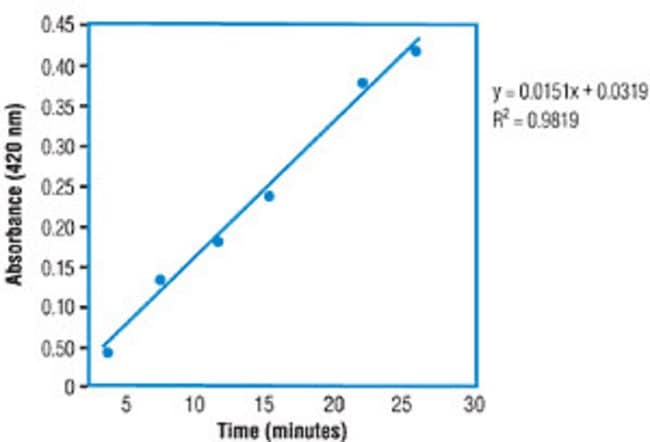| |
|---|
|
品名: | Yeast beta-Galactosidase Assay Kit |
产品简介:
规格
| 形式: |
96-well plate |
| 基质类型: |
Beta-Gal Substrate |
| Assay: |
Reporter Enzyme |
| Compatible Cells: |
Yeast Cells |
| Label Type: |
Enzyme Labeled |
| Substrate Properties: |
Chemical Substrate |
| 底物: |
ONPG |
| Target Enzyme: |
Beta-Galactosidase |
| Product Line: |
Pierce? |
| 技术.: |
Absorbance |
| Detection Method: |
Colorimetric |
| 适用于(设备): |
Microplate Reader |
内容及储存
Sufficient For: 250 colonies or 250 culture samples (100 μL each)
* Y-PER Yeast Protein Extraction Reagent, 25 mL (store at room temperature)
* 2X beta-Galactosidase Assay Buffer, 25 mL (store at -20°C)
* 1M Sodium Carbonate Stop Solution, 25 mL (store at room temperature)
描述
Thermo Scientific Yeast β-Galactosidase Assay Kit is specially formulated for yeast cells and ideal for identifying protein interactions in-vivo using two-hybrid systems.
Features of Yeast beta-Galactosidase Assay Kit:
* Efficient lysis of yeast cells and a colorimetric detection system
* Quantitative or qualitative assay for yeast colonies grown on solid media or in suspension
* Colorimetric assay easily measured in a plate reader or spectrophotometer (420nm)
* Adaptable to 96-well microplates or tube assay formats
* Allows cells obtained from solid media or liquid culture to be assayed directly with no harvesting or washing steps.* Perform homogeneous screening assays or measure activity secondarily after cell lysis
* Also compatible with prepared lysates from other species such as bacteria
Yeast β-Galactosidase Assay Kit allows qualitative or quantitative determination of β-galactosidase activity in solution directly from colonies growing on solid medium. A portion of the colony is suspended in a mixture of Thermo Scientific Y-PER Yeast Protein Extraction Reagent and β-Galactosidase Assay Buffer. After a brief incubation period, the solution turns yellow from the hydrolysis of o-nitrophenyl-β-D-galactopyranoside (ONPG) to o-nitrophenol (ONP) and galactose in a mildly alkaline solution. The assay becomes quantitative if calibrated to cell number by measuring the optical density at 660nm.
The gene encoding β-galactosidase (lacZ) of E. coli has been widely used as a reporter gene in many different prokaryotic and eukaryotic organisms. β-Galactosidase activity is also commonly used as an indicator of protein-protein interactions in-vivo using two-hybrid systems. The interaction strength is verified or quantitated using a β-galactosidase activity assay.
For Research Use Only. Not for use in diagnostic procedures.



































